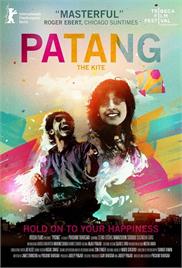Be Careful of Fake Websites. Always use HindiMovies.to domain & Join our Telegram Channel for Latest Updates.

Likes: 0
Views: 2.65K
In the city of Ahmadabad, six people are taken on an extraordinary journey during India’s largest kite festival. Each year a million kites circle the skies of the old city. Wishing to share the festival’s colorful splendor with his daughter, a thriving Delhi businessman takes her on a surprise trip to his childhood home. Yet among the music, fireworks, and light stirs thick emotions and fading dreams. He is forced to mend the broken relationships he left behind. A story of healing and renewal illustrated by actors and non-actors respectively, Patang offers a startling array of beauty and pain stirring among the kites in the sky.
Duration: 94 min
Released: 2012
IMDb Rating: 6.4/10 (148 Votes)
Genre: Drama, Hindi Movies
Stars: Mukkund Shukla, Nawazuddin Siddiqui, Seema Biswas, Sugandha Garg
Directors: Prashant Bhargava
Writers: Prashant Bhargava, James Townsend
Year: 2011
Server 1 – Estream
Server 2 – Vidto
Server 3 – Vidzi
Patang (2011) - A Poignant Exploration of Life, Struggles, and Humanity
Introduction
Patang, released in 2011, is a gripping Hindi-language drama that beautifully captures the essence of human emotions and survival against the backdrop of a vibrant yet challenging environment. Directed and written by Prashant Bhargava, the film intricately portrays the multifaceted layers of life in the hustle and bustle of Old Delhi, offering audiences an evocative narrative filled with hope, despair, and the relentless spirit to carry on.
Plot Overview
The story of Patang (which translates to 'Kite' in English) revolves around the theme of resilience and transformation. It lays out the lives of individuals entrenched in the chaotic streets of Old Delhi during the kite-flying festival, Makar Sankranti. The film elegantly uses the metaphor of the kite—soaring high yet tethered to a string—symbolizing the characters' aspirations and struggles in their socio-economic conditions.
The narrative primarily follows the life of a young boy and his family who have relocated from a rural village to the urban sprawl, in pursuit of a better life. They face unfamiliar challenges, discrimination, and the harsh realities of urban poverty. The kite festival serves as both a literal event in the movie and a metaphorical representation of hope, dreams, and the delicate balance between freedom and control.
Main Characters and Cast
Director and Writer
Prashant Bhargava helms the movie both as director and writer. His vision and storytelling style bring a unique, poetic realism to the film. Bhargava's direction is sensitive and subtle, allowing the setting and characters to breathe naturally within the story, making the viewer feel intimately connected to their lives and struggles. His screenplay balances moments of quiet introspection with pivotal scenes that highlight socio-economic issues.
Setting and Cinematography
The film is visually captivating, with cinematography that vividly captures the textures and colors of Old Delhi. The kite festival scenes are especially vibrant, filled with dazzling displays of kite battles in the sky, bustling streets, and the cacophony of city life. The urban landscape, juxtaposed with the traditional practices, provides a rich tapestry that supports the narrative beautifully.
Music and Sound
Unlike many mainstream Bollywood films, Patang is subtle in its use of music and does not rely heavily on song-and-dance sequences. The background score complements the tone of the film delicately, enhancing the emotional undercurrents without overwhelming the narrative. The director's choice to focus more on ambient sounds—the fluttering of kites, street noises, and everyday chatter—adds to the film's realistic and immersive atmosphere.
Thematic Depth
Patang deeply explores themes of displacement, the struggle between modernity and tradition, and the quest for identity in a complex social fabric. It sensitively handles the father-son relationship, showcasing the generational aspirations and the emotional tug-of-war that often exists in conservative Indian families facing change.
The kite itself is a potent symbol throughout the film. It reflects the fragile yet beautiful human condition — the tension between being free and grounded, the joys of simple pleasures, and the bitter realities tethering individuals to their circumstances.
Reception and Legacy
The movie received praise for its authentic storytelling, powerful performances, particularly by Nawazuddin Siddiqui, and its non-glamorized portrayal of urban life. It stands out as a heartfelt art-house film within Hindi cinema, appreciated by critics and audiences who look for depth and substance beyond commercial entertainment.
Conclusion
In summary, Patang (2011) is a bravura cinematic experience that melds poetic narrative, compelling performances, and strong social commentary. It invites viewers to ponder the complexities of life through the simple yet profound metaphor of a kite. For those interested in thoughtful cinema that reflects real life with emotional honesty and artistic integrity, Patang is a film to watch and cherish.